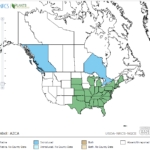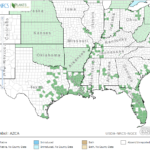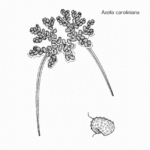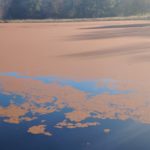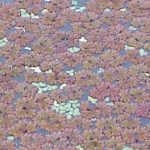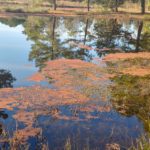Azolla spp.
USDA, NRCS. 2018. The PLANTS Database (http://plants.usda.gov, 28 March 2018). National Plant Data Team, Greensboro, NC 27401-4901 USA.
Illustration courtesy of University of Florida/IFAS Center for Aquatic and Invasive Plants. Used with permission.
What is Mosquito Fern (Azolla)?
Overview
Physical Characteristics
- Look like liverworts
Leaves:
- Free-floating
- Forming dense mats
- Small leaves arranged oppositely around stem
- 2-lobed
- Upper lobe floating
- Lower lobe under water
Fruit:
- Located on lower lobe of leaf
Color:
- Green when actively growing
- Red to brown when stressed
Where Does it Grow?
Mosquito fern grows in the still water of swamps, ponds, lakes, and in slow-moving water of streams and resting on mud.
Is it Invasive?
Although Mosquito ferns are native, they can be aggressive invaders in quiet ponds and are often found mixed in with duckweed or watermeal. If these fern colonies cover the surface of the water, then oxygen depletion and fish kills can occur. These plants should be controlled before they cover the entire surface of the pond.
Pros and Cons of Mosquito Fern
Dense colonies of mosquito fern provide habitats for many micro and macro invertebrates. They are used as food by fish and other wildlife species (e.g. amphibians, reptiles, ducks, etc.). After aquatic plants die, their decomposition by bacteria and fungi provides food (called “detritus”) for many aquatic invertebrates.
What Type of Mosquito Fern Do I Have?
There are two common species of mosquito fern that are common in Texas. Click on the buttons to learn more about each species.
